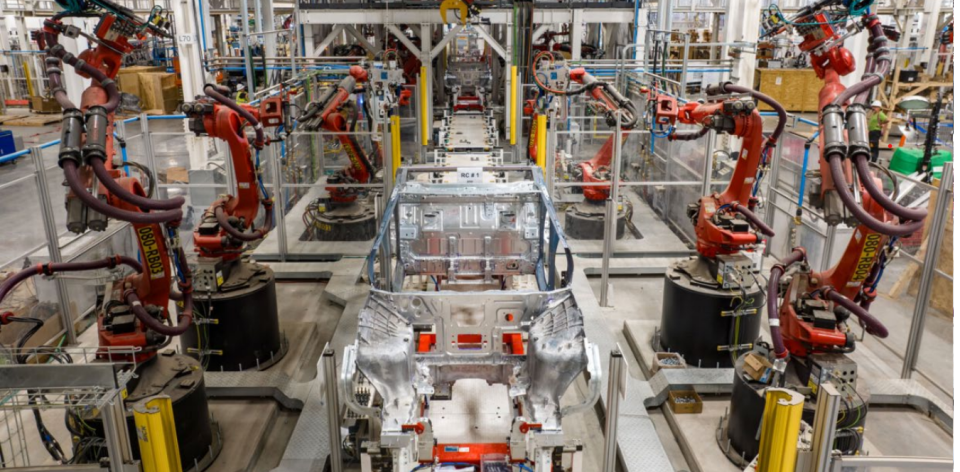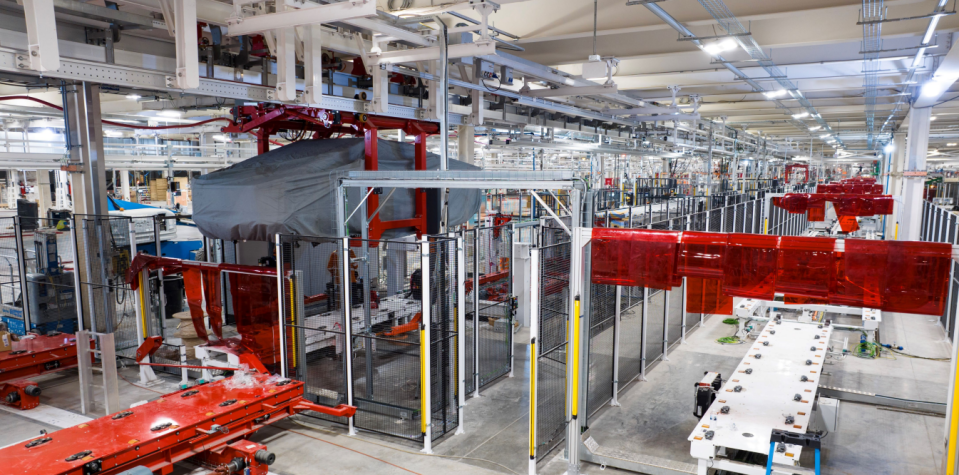Cybertrucks, record revenues and slim margins. Everything to know about Tesla's Q2 earnings
Austin-based Tesla reported record revenue but saw its overall margins dip, as the Austin-based carmaker continued to cut prices in the second quarter.
The company released its latest earnings report Wednesday, which comes as the electric vehicle maker moves closer to rolling out the first Austin-made Cybertrucks, which are expected to be ready later this year.
The Austin-based company reported that revenue was up nearly 50% but its gross margins dropped in its quarter ending June 30. In the report, Tesla said its net income was $3.15 billion, or 91 cents a share, which exceeded FactSet analyst expectations of 80 cents per share. The company saw low operating margins of 9.6%, and total gross margins of 18.2% both of which are the lowest in at least five quarters.
The company's revenue did rise nearly 50% to $24.9 billion, compared to $16.9 billion in the same quarter last year, and up from its first quarter revenue of about $23.3 billion.
How many vehicles did the company produce?
The company already released its production and delivery numbers earlier this month, saying it delivered 466,140 vehicles and that it produced 479,700 vehicles, comfortably beating analyst expectations of 445,925 deliveries. For Tesla, deliveries are the closest measure to sales that the company discloses.
The electric vehicle maker does not break out numbers by region or vehicle type, but rather by category. For Tesla's Model S sedans and Model X sport utility vehicles, the company produced 19,489 vehicles and delivered 19,225. In its Model 4 and Model Y category, the company produced 460,211 and delivered 446,915. Some of Tesla's Model Y vehicles are produced in Austin.
Why are margins down?
The sales came as Tesla continued to cut prices on a number of its most popular vehicles, allowing buyers to qualify for a $7,500 federal tax credit under the Inflation Reduction Act. Tesla made several rounds of price cuts since late last year amid increasing competition and a price war in the electric vehicle market.
But the cuts have drawn some concern from analysts and investors, worried about the potential for low margins. In the first quarter, Tesla reported a 24% drop in net income amid multiple rounds of vehicle price cuts.
Dan Ives, an industry analyst with Wedbush Securities, said in a note that the second quarter numbers are "better than feared" and overall it marks a "goldilocks” report for the automaker.
"Multiple rounds of aggressive price cuts has put Tesla in a position of strength after building its EV castle and now is set to further monetize its success," Ives said.
In a note, Thomas Monteiro, a senior analyst at Investing.com, said the company's overall trajectory remains positive. Monteiro also noted the report's focus was on the long-term narrative rather than the quarter itself, which is atypical for Tesla.
"Despite lower car prices, the company managed to mitigate the already-expected decline in margins, showcasing Elon Musk's adeptness at steering the company through both prosperous and challenging times," Monteiro said.
Despite beating or meeting expectations, Tesla stock dipped after hours, about 4.1%. The report also comes a day after Tesla shareholders, including Musk, settled a shareholder's lawsuit. The company is paying $735 million to shareholders to settle claims that board members overpaid themselves between 2011 and 2020.
What is the company up to in Austin?
Tesla's Chief Financial officer, Zachary Kirkhorn, said the company is "continuing to rapidly increase the build rate" of Tesla's Austin and Berlin factories, two of its newest gigafactories, as well as its energy business. He also said the company is continuing to invest heavily in core technologies that will drive Tesla's long-term value.
The company has been continuing to build out its massive manufacturing facility in Austin, which started delivering Model Y vehicles in April of 2022. Tesla also moved its headquarters to the same address in late 2021. In Austin, the company also said that it was having “continued success" ramping up Model Y production and has made progress on its 4680 battery cell production lines.
The company is also expected to make and start rolling out its long-anticipated Cybertruck later this year, and Musk noted on a call with investors the vehicle would be produced in high volume next year.
In its report, Tesla said it has started working on equipment installation for Cybertruck production, and said it is on track for initial deliveries this year and has started producing "release candidate" builds. The company also said on Twitter it is testing the Cybertruck “around the world” for its final certification and validation.
The company's report to investors also included several pictures of Cybertruck production in Austin, and employees with what appeared to be a completed Cybertruck.

On the call, Musk said the vehicle will be less than 19 feet long to allow it to fit in garages, while still having four doors, and a six-foot long bed, and will feel bigger on the inside than on the outside. He also said there is a "lot of new technology" in the vehicle, and it would have 10,000 "unique parts and processes."
Musk did not name pricing for the vehicle, but emphasized demand is strong for the truck.
"Demand is so far off the hook, you can't even see the hook," Musk said.
Battery production has also been ramping up in Austin, including the company's 4680 battery cells, according to Tesla Chief Financial Offeicer, Zachary Kirkhorn, who said that production increased by 80% in the second quarter compared to the previous quarter, as the team surpassed 10 million production cells produced in Texas.
The company also listed its Model Y production capacity in Austin as over 250,000 a year. The capacity marks a slight uptick from last quarter when executives said the Austin facility had increased production 50% quarter over quarter and the facility was capable of producing almost 250,000 Model Y's annually. In May, Tesla tweeted that it was able to produce 5,000 vehicles a week in Austin, a pace of nearly 260,000 vehicles per year.

"We continue to work on reducing our Austin and Berlin costs, which we did quite a bit (this quarter)" Kirkhorn said. "These factories are still slightly above Model Y production costs elsewhere. In the quarter, our mix of Austin and Berlin related builds increased."
Last year, Musk said the two facilities were burning money as they scaled up for production. Both factories are expected to play a key role in helping increase production for Tesla.
The company is also building out a facility near Corpus Christi to refine lithium, a key component in vehicle batteries. At a groundbreaking ceremony this year, Musk said the facility is expected to be completed in 2024 and increase to full production levels about a year later. On Wednesday, Musk said the facility is "progressing well."
In Texas, Tesla's energy business also started paying customers in Texas for participating in its virtual power plant to give ERCOT grid support, something the company expects to increase over time. The company started selling electricity in Texas to some customers last year.
The company also announced it was expanding Tesla electric enrollment to new model three owners in Texas, followed by all Tesla vehicles over the rest of the quarter. The company said that bringing Tesla electric to customers requires "working through a fractured regulatory environment on a jurisdiction-by-jurisdiction basis."

Elon Musk, Tesla continue to bet on AI
"We are continuing to invest heavily in the core technologies that will drive the long-term value of the business," Kirkhorn said, saying this includes AI-related technologies such as full self-driving software, Optimus, and Dojo, as well as new products including Cybertruck and Semitrucks. He also said that vehicle factories, internal applications and battery processes, and the supercharging network continue to expand.
Research and development costs rose sharply for Tesla to $943 million, up from $771 million the previous quarter, which the company said were in part related to artificial intelligence technology. On the call, Musk said Tesla will be spending more than $1 billion on Dojo, a supercomputer the company is using to develop AI machine learning, over the next year.
The company is also working on its humanoid robot, Optimus. Musk said there are five or six or 10 bots depending on what phase you count and said the company could start production of actuators that are able to walk, around November, and would ramp up after that. He said the first will be used in Tesla factories to prove utility.
"I think they will be able to do something useful in our factories sometime next year," Musk said.
Musk considers the robot key to Tesla's future. When it was first announced in 2022, the company showed a robot that could barely walk, but in May, an updated video showed the robot picking up items, recognizing objects, walking, and training on human movements.
The robot's artificial intelligence technology is based in part on Tesla's controversial full self-driving software. Currently, the full self-driving software is not considered fully autonomous by experts or the company itself.
Musk has promised the company would make a fully self-driving car since at least 2016, when he said that in 2017 the company would produce a car capable of completing a cross-country trip with no driver intervention. On Wednesday, Musk predicted the software would be "better than human (drivers)" by the end of this year, though he acknowledged that he has been wrong in the past on such predictions.
Musk spoke extensively about full self-driving technology throughout the call including announcing the ability to transfer the software between vehicles in the third quarter of this year only. The CEO also said the company is open to licensing the software with other companies.
"We are very open to licensing our full self-driving software and hardware to other car companies, and we are already in early discussions with a major (Original Equipment Manufacturer) about using the Tesla FSD," Musk said. "We're not trying to keep this to ourselves."
The company has also in recent months been announcing partnerships with other automakers including Ford, Mercedes and GM, related to its charging network, with many companies also announcing a switch to a Tesla-style charging plug.
The earnings report also came days after Musk announced a new company, xAI, a company which is expected to work with Tesla. On the call, in response to concern that the new company could hurt Tesla's own AI value Musk argued that xAI will "enhance the value of Tesla" and said it allows him to work with talented people who wanted to work for a startup rather than a more established company such as Tesla.
Musk has also commented extensively in recent years about the potential for AI to destroy humanity, while also saying that he believes AI will be key to Tesla's future. His new company was formed to "understand reality" but has given little detail about its plans, and would compete against OpenAI, which makes ChatGPT, a company Musk helped found, but has spoken out against in recent months.
This article originally appeared on Austin American-Statesman: Tesla revenues and cybertruck production in Austin AI second quarter
